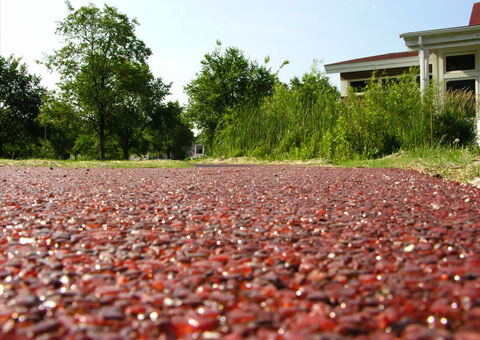Paving and Asphalt
Use Bound Recycled Glass Porous Pavement
What Is It?

FilterPave
Bound recycled glass porous pavement is similar to resin-bound paving except that a mixture of recycled glass and stone is used for the aggregate. The mixture can range from 100% recycled glass to 20% glass and 80% stone for heavier vehicular loads and longer service life. Bound recycled glass pavement is extremely porous, with void space of 39-47% (more than double that of porous asphalt and pervious concrete), reducing the rate of clogging and the need for maintenance. When clogged with sediment, infiltration rates were still measured at over six inches per hour, exceeding multiple stormwater standards.
As with other permeable pavements, periodic vacuuming will help maintain infiltration rates, though many installed systems have maintained normal functionality after five years without vacuuming. In addition, higher glass-content mixtures (50%+) will require a topcoat every two to three years depending on traffic load to prevent shedding. Recycled glass pavement will also contribute to LEED credits: the pavement is comprised of regionally-sourced, recycled materials, has a solar reflective index of 29 to 62, and permeability and filtration rates meet LEED standards.
Benefits
- Enhances groundwater infiltration while reducing stormwater runoff volume, rate, and pollutants.
- Recycled glass and aggregate reduce urban heat island through increased reflectivity and evaporative cooling
- Wide range of glass colors can help preserve urban aesthetics
- Recycled content: approximately 90 glass beverage bottles used in every square foot of paving
- Highest porosity of other porous pavements, reducing clogging and need for vacuuming
- Resistant to freeze-thaw cycles and extreme heat—binding agent expands and contracts easily
- Reduces occurrence of black ice/freezing puddles in cold climates; requires less applied deicers
Drawbacks
- Pollutants and deicing salts can infiltrate groundwater—should not be installed in areas where hazardous material spills are possible
- Higher glass mixtures require additional maintenance (topcoat every two to three years)
- More expensive than other types of permeable pavement
- Snow removal can be more difficult than with other types of paving. Plows must use polycarbonate type-cutting blades
Regulatory Impacts and Requirements
Potential regulatory touchpoints in Boston and Massachusetts include:
- MA Historical Commission/Boston Landmarks Commission
- Architectural Access Board
- Zoning Board of Appeals
- Public Improvement Commission
- Boston Public Works Department
- Local Utilities
- Boston Water and Sewer Commission
- Boston Groundwater Trust
Financing Options, Incentives, and Rebates
- Municipal stormwater abatement service fees – Municipal-level
- Coastal Pollutant Remediation (CPR) Grant Program – MA State
- Clean Water State Revolving Fund (SRF) – MA State
- Section 319 Nonpoint Source Competitive Grant – Funding provided under federal Clean Water Act
- 604b Water Quality Management Planning Grant – Funding provided under federal Clean Water Act
- Drinking Water Supply Protection Grant Program – MA State
NEWS
- "Recycled Glass Paves a Path at Trailside Museum" Patch, July 2011


